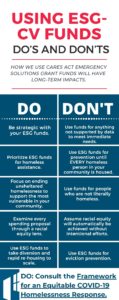To protect people experiencing homelessness during the COVID-19 pandemic, Congress appropriated $4 billion for the Emergency Solutions Grant program via the CARES Act (ESG-CV). This is an enormous investment (approximately 17 times the usual annual ESG appropriation) that has the potential to help countless people exit homelessness and stay safer and healthier during the pandemic — but only if it is efficiently and effectively targeted. And that means a focus on those who are already homeless.
 ESG should be preserved for people currently experiencing homelessness.
ESG should be preserved for people currently experiencing homelessness.
Now that the entire $4 billion of ESG-CV funding has been released, grantees will be considering how to use it, including how much to invest in helping people who are already homeless versus preventing homelessness. Experience and evidence give us a straightforward answer. If you want to seize some benefit from this devastating public health emergency, you should first use these funds to help all the people currently experiencing homelessness get into safe temporary housing, and then permanent housing and connected with services. Only when all are homeless people are housed, should you consider prevention with this funding stream. This is both because people who are literally homeless are at the highest risk from the disease AND because homelessness prevention programs are notably ineffective at preventing homelessness because of the difficulty of predicting who will actually become homeless.
Eviction prevention and homelessness prevention are not the same thing.
Homelessness prevention is most frequently delivered as eviction assistance. It is a common misconception that a good way to prevent homelessness is to prevent eviction for people who are assumed will probably become homeless if they lose their housing (people who are low income and have an eviction notice). But most of the time, this is not actually true.
Traditional low-income eviction prevention programs tend to assist households with very little risk of ever entering shelter in the first place. A Chicago study, for example, found that of low-income households with eviction notices, who had applied for eviction assistance but did not receive it due to insufficient funding, only 2.1% later entered a homeless shelter program. Being very low income and having an eviction notice does not predict homelessness.
Further, very few households that do become homeless come from a home in which they were the leaseholder. By far the largest percentage of people who enter homelessness do so from a doubled-up situation in which they are not the leaseholder.
While eviction prevention does not reliably prevent homelessness, it is important and helps stabilize people in housing. Eviction prevention can and should be funded by mainstream system resources, including CDBG, TANF (for families), the Coronavirus Relief Fund, etc. Resources in the HEROES Act (proposed by the US House of Representatives) could also make a significant contribution. It should not, however, be the focus of ESG-CV funds targeted to address homelessness.
Focusing on those currently homeless addresses racial equity.
People of color who experience homelessness, particularly African Americans, often have more complex problems as a result of having been the target of historic and systemic racism. As a result of discrimination, they have had disproportionate interaction with the criminal justice system, less access to quality health care, more involvement in the child welfare system, poorer health, less access to quality and healthful food, poorer educations, less job opportunity and advancement, etc.
Targeting people with lesser needs for homelessness prevention/eviction assistance can result in those with more complex problems going un-served and further perpetuate racial disparities in homelessness. To be more equitable with respect to race, higher-need people must not be overlooked or de-prioritized.
To address the front door into homelessness, take diversion to scale.
There is very little evidence that allows us to predict, and therefore to prevent, homelessness (although much work is being done in the area and new tools may soon emerge). What would make more sense, if you want to address the front door into homelessness, would be to focus on diversion: assisting people who have already lost their housing and become homeless to find alternative places to stay and avoid shelter, or unsheltered homelessness. This eliminates the need to predict who will become homeless, improving efficiency and effectiveness. Diversion requires the kind of flexible funding that ESG-CV can provide. Homeless service system data shows dramatically reduced entries to shelter or services when comprehensive diversion is employed.
Conclusion
With the $4 billion in new ESG-CV resources, states and localities have an unprecedented opportunity to help people experiencing homelessness stay safe from acquiring or transmitting COVID-19, while also receiving the support they need to escape homelessness and position themselves for the recovery period. If these resources are significantly devoted to prevention of homelessness through eviction assistance – which data show rarely ends homelessness – this opportunity will be lost, and people’s lives will be put at risk. Therefore, where there are still people experiencing homelessness, ESG-CV funding should be used to ensure their safety and end their homelessness, rather than for broader prevention initiatives, including eviction prevention.
Download the Using ESG-CV Funds infographic >>>

